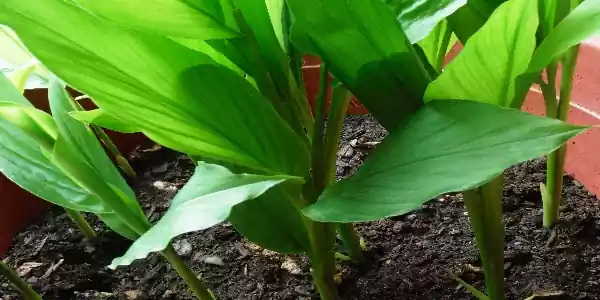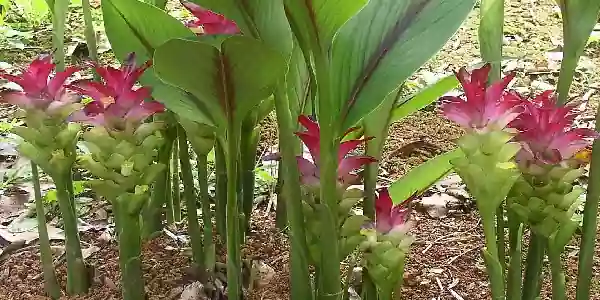The turmeric plant produces the bright yellow spice that most people know from Indian cuisine. This spice is warming and has a slight bitter taste on its own. Many liken it to the combination of orange and ginger. It’s used in many different cuisines, though most people only know it is a main ingredient in curry. Turmeric is also in common things, like mustard, because it naturally gives them its bright yellow hue. The turmeric plant has long been thought of as a healing plant in ancient Chinese and Indian medicine. There are many benefits from adding turmeric into your diet, and even considering growing the plant.
How to Grow Turmeric
The turmeric plant must be grown in a hot environment. If you live in a warm area, you may be able to grow turmeric outside of your home. This plant is different because the turmeric doesn’t come from the leaves, but from the roots instead. The plant grows a tuber, like ginger, into its roots. This is not a plant that can be continuously harvested throughout the season. The roots take up to ten minutes to fully grow, which means you’ll have one harvest, rather than several harvests throughout a season. To begin growing the turmeric plant, you must start from the roots or sprouts, and not from a seed. If you can grow turmeric in your environment, your local nursery will most likely sell turmeric roots. You should purchase several roots or sprouts once you’ve located them. Not all roots or sprouts will work, so you’ll want to be sure to buy several just in case you purchase a dead root. Once you’ve obtained the root, it’s very simple to begin growing them.

If you find a turmeric plant root that has several branches, you can cut these branches apart and plant them separately or plant them as one. From here, you should plant the roots in about two inches of soil. Keep the soil damp but not wet. In about a month, you should see some growth from your plant. It can take up to ten months for the roots to follow grow turmeric, so be sure to properly care for your plants in different weather conditions.
Benefits
Adding the turmeric plant to your diet can have many health benefits. Turmeric has been used as a natural anti-inflammatory medicine. Turmeric contains curcumin, which gives it its bright yellow color. Curcumin has been shown to have the same anti-inflammatory effects as certain over the counter drugs, like Motrin or Aleve. The difference between curcumin and an over the counter drug is that it doesn’t create any other side effects in the body. Motrin can lead to stomach ulcers and can create toxins within the body while curcumin is a pure substance.
The turmeric plant has also been used to treat various ailments like colic, menstruation discomfort, toothaches, bruises, and jaundice. Curcumin that is found in the turmeric plant has also shown to significantly relieve pain in those who suffer from arthritis. Curcumin neutralizes free radicals. Free radicals move throughout the body and damage healthy cells. In arthritis, free radicals have attacked the healthy joint and can cause painful swelling in the process. The attack on the joint can leave the joint in constant pain for many arthritis sufferers. Because turmeric also has anti-inflammatory properties, the combination of the anti-inflammatory and free radical neutralizing, has caused much needed relief for people with arthritis. The plant has allowed them to move more, has decreased the stiffness they feel in joints, and has reduced the swelling in their joints.

How to Store Turmeric
The turmeric plant is best when it is preserved properly to maintain the flavor. When buying turmeric, look for a turmeric root or powder that is finely ground. If you are looking for a ground, look for a rich, yellow color. Store the turmeric powder in an airtight container then place it in a dark, cool place. Avoid placing turmeric near heat, light or air – all of which can reduce the flavor power of turmeric. Whole turmeric can last for up to five years, while ground turmeric will stay fresh for six months. Never store any type of herb with turmeric or store turmeric in the refrigerator, near humidity – these will destroy the flavor of the turmeric spice.
When buying turmeric, you want to buy as little as possible. As turmeric loses its color it will also lose its flavor. Turmeric can also be stored in ice cubes of frozen vegetable or chicken stock, used in chutneys, pickles and relish – as long as you perform proper canning techniques.

Substitutes for Turmeric Plant
Not everyone can handle the pungent taste of turmeric. Though turmeric has a pleasant scent and flavor, but the color adds more to the dish than flavor for many people. Since turmeric is often used in curry powders, pickling liquids and mustard, the color helps adds vibrancy with a slightly spiced flavor. Turmeric can also stain cabinets, clothing and towels in the kitchen, which makes it a difficult spice to work with. If you are looking for a substitute for turmeric, luckily you are not out of luck. If the recipe calls for one teaspoon of fresh turmeric, you can use one teaspoon of ground turmeric. Other substitutes for turmeric can include:
- Mustard powder
- Mustard seed
- Prepared mustard
- Pinch of saffron
- Annatto seeds
- Ginger
Remember that turmeric plant does have a required taste to it. Therefore, when working with turmeric you can use it in small amounts until your tastes become accustomed to the bitterness that fresh turmeric and ground powder often add to the dish. It is also important to realize that some people can suffer from an allergic reaction to turmeric. If you have a history of allergies you will want to consult your physician to ensure that you will not have an allergic reaction to the turmeric upon consumption.
